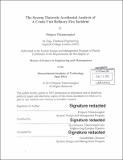The system theoretic accidental analysis of a crude unit refinery fire incident
Author(s)
Thammongkol, Pitiporn
DownloadFull printable version (10.92Mb)
Other Contributors
System Design and Management Program.
Advisor
Qi Hommes.
Terms of use
Metadata
Show full item recordAbstract
Catastrophic chemical process accidents in the past such as Bhopal (India) and Flixborough (UK) have led to a major increase in societal concerns about the safety of these processing facilities. As the petrochemical industry has changed considerably over the past several decades due to changes in technology, automation control and greater integration of work services, this has led industry operations to become more advanced and complex. Therefore, when accidents occur, they usually have an involvement of multiple factors, which suggests that there are underlying complex systemic problems. Nevertheless, typical accident investigations often show that most accidents were preventable; identifying the cause of the accidents and monitoring warning signs are crucial to preventing the accidents. The main objective of this thesis is to develop a better understanding of the missing causal identification from the use of traditional Swiss cheese base accidental model compared to a structured system-based method. This thesis applies Prof. Leveson's System Theoretic Accident Model and Processes, STAMP-CAST, on a case study of the August 2012 Richmond Refinery fire involving a crude unit. Then STAMP-STPA will be use in an example to develop warning signs to detect the deterioration of the Refinery's safety integrity. The analysis identified is complimentary to the refinery and regulatory controls that were not articulately expressed in the company's investigation report. These analyses are included in subsequent sections of this thesis to answer the research question "What could be done differently to understand the causes of accidents and prevent them?"
Description
Thesis: S.M. in Engineering and Management, Massachusetts Institute of Technology, Engineering Systems Division, System Design and Management Program, 2014. 40 Cataloged from PDF version of thesis. Includes bibliographical references (pages 112-115).
Date issued
2014Department
System Design and Management Program.; Massachusetts Institute of Technology. Engineering Systems DivisionPublisher
Massachusetts Institute of Technology
Keywords
Engineering Systems Division., System Design and Management Program.